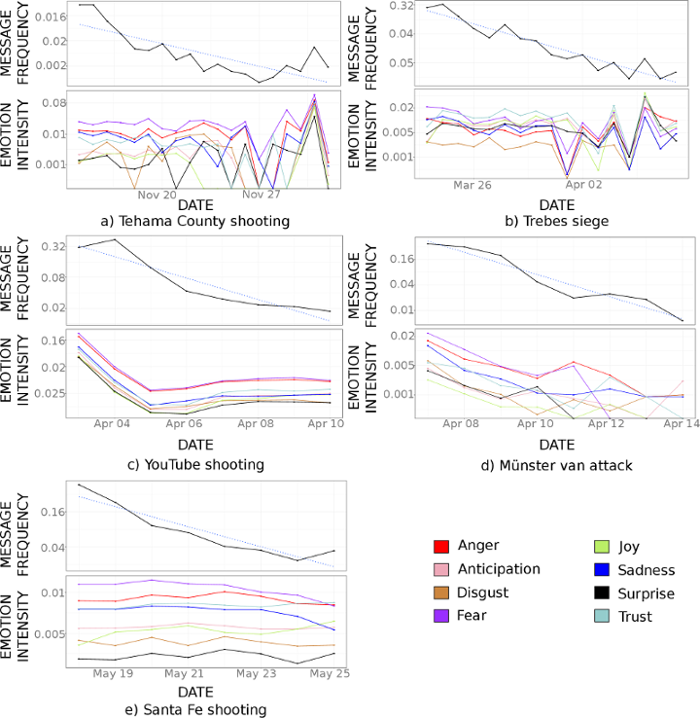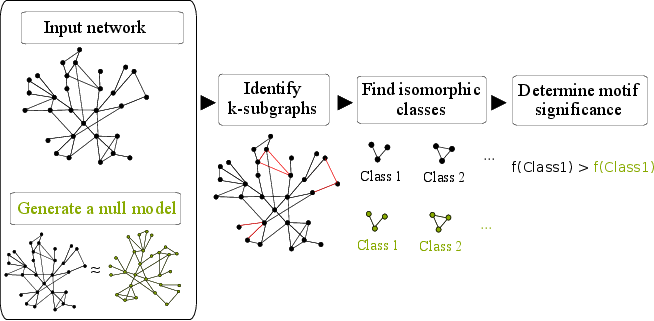WU data-science project provides an analysis on how shootings and terror attacks affect social media communication behavior
(Thursday, April 4th, 2019, 09:15 CEST)
A new study conducted by WU researchers that has been published in March 2019 provides novel insights how shootings and terror attacks affect the emotions and the corresponding communication behavior of social media users. For the study, five shootings and terror events have been analyzed that happened in three different countries (France, Germany, USA).
Abstract

Figure 1: Message frequency and emotion intensity that occurred during the five events.
In a data-science project that is located in a computational social science context, Mag. Ema Kušen and Prof. Mark Strembeck of WU's Institute of Information Systems and New Media study which types of emotions are triggered by different types of real-world events and how these emotions affect the communication behavior of social media users (e.g. on Facebook, Twitter, or YouTube).
The new study investigates how shootings and terror attacks influence the communication behavior of social media users. In particular, it focuses on the identification of characteristic communication patterns that occur when social media users exchange emotional messages. To this end, Ema Kušen and Mark Strembeck introduced the novel concept of "emotion-exchange motifs". An analysis of corresponding patterns helps improve the understanding of social media based communication in general. Moreover, they also provide insights into the properties of the processes that promote the spread of desired as well as undesired social media messages (such as propaganda). Last but not least, such patterns may contribute to improving techniques for the detection of "social bots" (see, e.g., [KS2018]).
Research Procedure

Figure 2: Research procedure
First, the public APIs provided by Twitter have been used to systematically collect different data-sets. For the subsequent analyses, the data-sets have been anonymized. In particular, the following five events have been analyzed (see also Figure 1):
- November 2017: Shooting in Northern California (5 people killed including the shooter, several people wounded. A potentially much larger number of fatalities was averted when the shooter wasn't able to break into an elementary school because the doors had been secured).
- March 2018: Supermarket siege in Trèbes, France (5 people killed including the shooter, several people wounded).
- April 2018: Shooting at the Google headquarters, San Bruno, California (the shooter killed herself after wounding 3 victims).
- April 2018: Van attack in Münster, Germany (3 people killed including the suspect, more than 20 people injured. Almost four months after the attack a fourth victim died of his injuries).
- May 2018: School shooting in Santa Fe, Texas (10 people killed, 13 wounded).
The different analyses conducted for the study include structural network analyses as well as temporal analyses concerning the impact of different emotions (anger, anticipation, disgust, fear, joy, sadness, surprise, and trust [KCFCS2017]). In contrast to most preceding studies (see, e.g., [KSC2019]) the new study focuses on a structural analysis of communication relations on Twitter and the identification of "emotion-exchange motifs".
Results

Figure 3: Procedure for identifying emotion-exchange motifs
As expected, on the day the respective shooting or terror attack occurred, the emotions of anger, fear, and sadness dominated in the corresponding Twitter messages. However, soon after those first reactions a considerable number of messages occurred that conveyed positive emotions, especially expressing empathy and consolation. This result confirms the findings of previous studies and can be seen as another endorsement of the "undoing hypothesis" (for further details, see, e.g., [KSC2019]).
In addition to the temporal analysis concerning the impact of different emotions, the new study especially focuses on the identification of characteristic communication patterns that arise from the exchange of emotional social media messages. To this end, the study applied the novel concept of "emotion-exchange motifs". The same concept has already been successfully applied in a previous investigation which analyzed social media communication behavior during riot events (see [KS2018]).
"Emotion-exchange motifs" are a particular type of "network motifs". Network motifs are statistically significant communication patterns, i.e. patterns that do not appear by chance. In order to determine if an "emotion-exchange motif" has a semantic meaning and results from the communication patterns in a real-world network, one generates corresponding null models and checks if the motifs found in the real-world network are also found in the corresponding null models. If the motifs appear significantly more often in the real-world network, they most likely result from the corresponding real-world communication patterns rather than a random process (see also Figure 3).

Figure 4: Characteristic emotion-exchange motifs for the communication of anger and fear
When analyzing direct message exchanges between Twitter users, Ema Kušen and Mark Strembeck identified nine emotion-exchange motifs that occurred during the five events. An interesting result suggests that emotion-exchange motifs which contain reciprocal edges (indicating online conversations) only emerge when users exchange messages that convey anger or fear, either in isolation or in any combination with another emotion. In contrast, the expression of sadness, disgust, surprise, as well as any positive emotion are rather characteristic for emotion-exchange motifs representing one-way communication patterns (instead of online conversations). This result indicates that negative high-arousal emotions (anger and fear) are suitable for starting social media discussions. Therefore, social media messages conveying anger or fear may also be used to provoke social media users to send replies and thereby contribute to spreading a message.
Moreover, the new study empirically shows that specific emotions (such as anger and fear) are also triggered and expressed online in each phase of a shooting or terror event (during the event as well as as after the event), thereby confirming the emotions predicted by other studies such as the "Integrated Crisis Management" (ICM) model. Thus, the new results indicate that short social media messages (such as tweets) are already a good enough indicator of publicly expressed emotions.
Another interesting insight that results from a previous study [KS2018] indicates that the communication of humans and "social bots" (software programs that automatically produce messages and interact with human users on social media platforms) also produces characteristic "emotion-exchange motifs".
Further Reading:
- [KS2019] E. Kušen, M. Strembeck: An Analysis of Emotion-exchange Motifs in Multiplex Networks during Emergency Events, In: Applied Network Science, Vol. 4, March 2019
- [KSC2019] E. Kušen, M. Strembeck, M. Conti: Emotional Valence Shifts and User Behavior on Twitter, Facebook, and YouTube, In: Influence and Behavior Analysis in Social Networks and Social Media, Lecture Notes in Social Networks (LNSN), Springer, February 2019
- [KS2018] E. Kušen, M. Strembeck: Investigation of Emotion Exchange Motifs in Bot/Human Interactions during Riot Events, In: Proc. of the 5th International Conference on Social Networks Analysis, Management and Security (SNAMS), IEEE, Valencia, Spain, October 2018
- [KCFCS2017] E. Kušen, G. Cascavilla, K. Figl, M. Conti, M. Strembeck: Identifying Emotions in Social Media: Comparison of Word-emotion lexicons, In: Proc. of the 4th International Symposium on Social Networks Analysis, Management and Security(SNAMS), IEEE, Prague, Czech Republic, August 2017
Contact:
Mark Strembeck
Ema Kušen